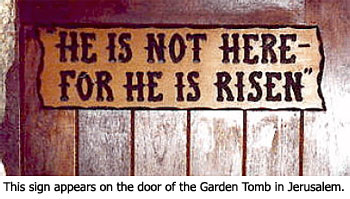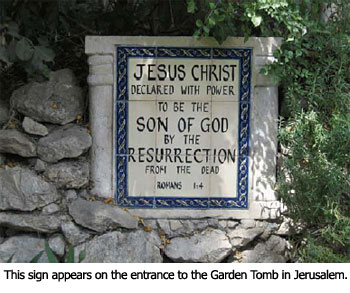The Resurrection of Jesus
Its Reality and Essentiality

“Jesus said to her [Martha] I am the resurrection and the life; he who believes in Me shall live even if he dies…” – John 11:25 (NASV)
There can be no certainty whatsoever about life after death unless Jesus was raised from the dead. Christianity stands or falls on the truth of Jesus’ resurrection, as does any hope of life after death.
The Testimony of Paul
The Apostle Paul made this point clear in his writings. When defining the essence of the Gospel, he wrote that it was the death, burial, and resurrection of Jesus (1 Corinthians 15:3-4).
To make his point crystal clear, he added, “…if Christ has not been raised, then our preaching is vain, your faith also is vain” (1 Corinthians 15:14). And then, as if to make certain to get his point across with no misunderstanding, he repeated his assertion, “…and if Christ has not been raised, your faith is worthless; you are still in your sins” (1 Corinthians 15:17).
The Testimony of Jesus
Jesus Himself asserted that our hope of resurrection depended upon His own triumph over death. Sixty-five years after His resurrection, He appeared to the Apostle John on the island of Patmos and made this remarkable statement (Revelation 1:17-18):
Do not be afraid; I am the first and the last, and the living One; and I have the keys of death and Hades. Think on that statement for a moment. Jesus is saying, “I am the beginning of history. I am the end of history. I am the meaning of history. And because I have overcome death, I have authority over death (the body) and Hades (the spirit).”
The Testimony of the Apostles
All the apostles recognized fully the significance of Jesus’ resurrection, and because of that, His resurrection became the focal point of their preaching.
Peter, in the first Gospel sermon ever preached, reminded his audience that King David had prophesied that the Messiah would be resurrected from the dead (Psalm 16:10). He then proclaimed that Jesus had fulfilled that prophecy: “This Jesus God raised up again, to which we are witnesses” (Acts 2:32).
In Peter’s second sermon, delivered on the Temple Mount, He charged his audience with participating in the execution of Jesus by demanding that the “Prince of Life” be put to death, “the one whom God raised from the dead, a fact to which we are witnesses” (Acts 3:14-15).
Peter’s third sermon was delivered to the Sanhedrin Council, the very group of Jewish leaders who had condemned Jesus to death. Filled with the Holy Spirit, Peter bravely proclaimed, “…let it be known to all of you, and to all the people of Israel, that by the name of Jesus Christ the Nazarene, whom you crucified, whom God raised from the dead… there is salvation in no one else” (Acts 4:10, 12).
Speaking of the boldness of the apostles in their preaching, Luke wrote, “And with great power the apostles were giving witness to the resurrection of the Lord Jesus…” (Acts 4:33).
When all the apostles were arrested and hauled before the Sanhedrin Council and were threatened if they did not stop preaching, “Peter and the apostles answered and said, ‘We must obey God rather than men. The God of our fathers raised up Jesus, whom you had put to death by hanging Him on a cross'” (Acts 5:29-30).
As Stephen, the first Christian martyr, was being stoned to death for his testimony of Jesus, “he gazed intently into Heaven and saw the glory of God, and Jesus standing at the right hand of God, and he said, ‘Behold, I see the heavens opened up and the Son of Man standing at the right hand of God'” (Acts 7:55-56).
When Peter was called to preach to Cornelius, the first Gentile convert, he spoke of the crucifixion of Jesus, and then he said, “God raised Him on the third day, and granted that He should become visible, not to all people, but to witnesses who were chosen beforehand by God, that is, to us, who ate and drank with Him after He arose from the dead” (Acts 10:40-41).
When Paul was called and sent forth as a missionary (Acts 13:1-4), his sermons focused on the resurrection as the cardinal event of history, emphasizing that Jesus’ resurrection was a fulfillment of prophecy: “And we preach to you the good news of the promise made to the fathers, that God has fulfilled this promise to our children in that He raised up Jesus… from the dead, no more to return to decay…” (Acts 13:32-34).
In Thessalonica Paul reasoned with the Jews in the synagogue, “explaining and giving evidence that the Christ had to suffer and rise again from the dead…” (Acts 17:3).
At Athens, we are told that Paul “was preaching Jesus and the resurrection” (Acts 17:18).
And when Paul was arrested and brought before King Agrippa, he said, “I stand to this day testifying both to small and great, stating nothing but what the Prophets and Moses said was going to take place; that the Christ was to suffer, and that by reason of His resurrection from the dead, He should be the first to proclaim light to both the Jewish people and to the Gentiles” (Acts 26:22-23).
As you can see, over and over again the apostles affirmed the resurrection of Jesus and asserted that it is the heart of the Gospel.
Paul’s Letters
Accordingly, Paul began his profound theological epistle to the Romans by asserting that he was an apostle called to preach the Gospel concerning Jesus Christ, “who was declared the Son of God with power by the resurrection from the dead…” (Romans 1:1-4). Later, in the same letter, Paul stated, “…that if you confess with your mouth Jesus as Lord, and believe in your heart that God raised Him from the dead, you shall be saved” (Romans 10:9). And when Paul wrote to his protégé, Timothy, he exhorted him in his teachings to “remember Jesus Christ, raised from the dead, descendant of David, according to my gospel” (2 Timothy 2:8).
In 1 Corinthians 15:5-8 Paul emphasized the validity of the Resurrection by recounting some of the appearances that Jesus made after His resurrection. He states that Jesus appeared to Peter and then to all the apostles, and that after that, He appeared to more than 500 brethren at one time. He also appeared to His brother, James, who later became the leader of the church in Jerusalem. Paul then reminds his readers that Jesus appeared to him, referring to his conversion experience on the road to Damascus (Acts 9:1-9).
The Overall Significance
The overwhelming significance of the resurrection of Jesus is to be seen in the fact that it is an event that sets Christianity apart from all other world religions.
The Resurrection is the unique stamp of Christianity, for only Christianity can claim an empty tomb for its founder. No resurrection has ever been claimed for Abraham, Buddha, Confucius, or Mohammed. It is no wonder that Peter claimed that “our living hope” is based on “the resurrection of Jesus Christ from the dead” (1 Peter 1:3).

I believe it was the great Bible teacher, Walter Martin (1928-1989), who once summarized the significance of the Resurrection with this observation: “The resurrection of Jesus Christ is either one of the most wicked, vicious, heartless hoaxes ever foisted upon the minds of men, or it is the most fantastic fact of history.”
The Empty Tomb
Let’s consider the evidence of the Resurrection, and in doing so, we must start with the fact of the empty tomb.
The Gospels tell us that Jesus was buried in the tomb of a wealthy man, Joseph of Arimathea (Matthew 27:57-60). Three days later that tomb was empty. It was empty despite the fact that it had been sealed by a huge stone weighing close to two tons and despite the fact that it had been guarded continuously by Roman soldiers (Matthew 27:62-66 and Mark 15:43-46).

The Scriptures reveal not only the careful security precautions which were taken by both the Jews and the Romans, they also reveal that the Jews did not challenge the fact that the tomb was empty. That’s because the tomb was empty! They could not argue with that fact, so they manufactured a story to explain why it was empty. They paid the Roman guards of the tomb to say that Jesus’ disciples had stolen his body during the night while the guards were sleeping! (Matthew 28:11-14)
Again, the tomb was empty! No one could deny that fact. Liars had to be hired to provide an explanation.
A Modern “Explanation”
What’s worse is that men have been concocting silly stories ever since to try to explain away the resurrection of Jesus.
I experienced a startling explanation back in the 1980’s when I ran across an Easter sermon in the Dallas Morning News that had been preached by a seminary professor to a group of students at a university in Dallas. He argued that the disciples’ reaction to the crucifixion of Jesus was similar to what happened among the followers of Martin Luther King after his assassination.
He explained that as King’s followers sat around and reminisced about his speeches and their experiences with him, he became alive in their hearts. “That’s all there was to the Resurrection,” he told the students. “The memory of Jesus began to burn in the hearts of His disciples as they reminisced about Him.”
So the disciples of Jesus gave their lives to heart burn? Again, what total nonsense!
Other Explanations
Let’s consider some of the arguments against the Resurrection that have been offered throughout history. As we do so, I think you will sense that the shallowness of the skeptics’ arguments speak louder, in many respects, than the counterarguments of Christians.1
1) Confusion — Perhaps the silliest argument of all is that the disciples went to the wrong tomb! Yes, some supposedly learned men have proposed this theory over the years.
Yet, the Gospel accounts tell us that Mary Magdalene and Mary, the mother of Jesus, both accompanied Joseph of Arimathea and Nicodemas to the tomb and watched them prepare the body for burial (Matthew 27:56-61 and John 19: 38-42). Are we to suppose that when the women returned they could not find their way?
And even if they did get lost and looked in the wrong tomb, did Peter and John do the same thing? Did the Roman soldiers forget which tomb they were guarding? Did Joseph of Arimathea suddenly have a memory lapse as to where his tomb was located? And why didn’t the Jewish leaders simply go to the right tomb and produce the body?
The answer is simple: the tomb was empty!
2) Theft — The oldest explanation of the empty tomb is the one the Jews made up and bribed the Roman soldiers to tell — namely, that the body of Jesus was stolen by His disciples. Yes, this explanation would have us believe that Peter, Andrew, James and John were body snatchers!
Now wait a minute. Are we really to believe that a small rag-tag band of followers who were scared witless at the arrest of Jesus and who fled into the night to save their own skins, suddenly found the courage three days later to take on a guard of Roman soldiers?
Even more significant, what would have been the motivation of the disciples to steal the body? We’re told over and over again in the Scriptures that they did not understand that Jesus was to be resurrected (Mark 9:30-32). Their behavior after the crucifixion testified to this as they sat around in despair mourning the loss of their leader.
And yet, this very group suddenly came alive with hope and went forth boldly proclaiming the Resurrection at the risk of their lives. Are we really to believe that a group of frightened disciples could be transformed into a courageous band of fearless proclaimers by snatching a body, hiding it, and then committing their lives to a lie? That’s more difficult to believe than the Resurrection!
3) Hallucination — One of the popular modern day theories has been the idea that the disciples experienced a series of hallucinations. As one advocate of this novel concept has put it, “They experienced a disruption of the physio-chemical structures of the brain in such a way as to be able to see what they desperately wanted to see.”2
I will grant that Mary Magdalene might have had an hallucination. After all, she was a frightened and frustrated young woman wandering around in a cemetery at day break. As a matter of fact, the reaction of the disciples to her news of the empty tomb and her encounter with angels who informed her of the Resurrection indicates that they thought she had been “seeing things” (Luke 24:11).
But what about the appearance of Jesus to all the apostles on three different occasions, or His appearance to 500 believers on a Galilean mountain, or His ascension before a host of disciples? (1 Corinthians 15:5-7 and Acts 1:1-11).
An hallucination is a highly subjective experience and a very personal one. Like beauty, it is in the eye of the beholder. To believe that 500 people could have the same hallucination simultaneously takes more faith than a belief in the Resurrection! And furthermore, the hallucination theory does not explain the empty tomb.
4) Hypnosis — Another modern theory is that the disciples experienced mass hypnosis. The advocates of this idea argue that the disciples so desperately wanted Jesus to rise from the dead that they created an aura of auto-suggestion (or mental hypnosis) and thus, whenever the name of Jesus was mentioned, His disciples believed they could see Him.
Now, mass hypnosis is a probability, with even as many as 500 people, given precisely the right type of controlled environment and the proper mass medium like radio, television, or film. But mass hypnosis without some form of mass media, and without a professional hypnotist, and without ideal conditions, is utterly outside the realm of sound reasoning.
So, I ask you, how could 500 people in the open air of a country side, before the invention of mass media, and before the discovery of hypnosis, be subject to mass hypnosis? And how does this explain the fact of the empty tomb? I think it’s obvious that the skeptics are grasping at straws.
5) Fainting — This leaves us with a centuries old theory that has been resurrected and popularized by an apostate Christian named Hugh Schonfield. It’s called the “swoon theory.”
This is the idea that Jesus really didn’t die on the cross. Instead, He just passed out and then woke up three days later. Schonfield revived this idea in 1965 in his book called The Passover Plot.3
Mr. Schonfield would ask us to believe that after Jesus was scourged and crucified, and after He had laid in a cold, damp tomb for three days without food or water, He suddenly revived, removed His burial wrappings, rolled back the stone, and ran around the country side for 40 days without the benefit of even a dose of penicillin or a tetanus shot. Only a fool could believe such utter nonsense!
6) Nostalgia — There is one other theory that has become very popular among modern day liberal theologians. It is what I call the “nostalgia theory.” It’s the idea I mentioned earlier that the Resurrection occurred only in the hearts of the disciples.
Such a ridiculous concept is a natural outgrowth of liberal apostasy because it leaves them with the kind of Jesus they like — one who was only human. Their “messiah” turns out to be a man who meant well, but who in reality was a deluded fool who thought he was God in the flesh.
This theory denies the well documented post-Resurrection appearances of Jesus, and like all the other theories, it fails completely to explain the fact of the empty tomb.
A Summary
The tomb of Jesus was empty. It was empty not because it was the wrong tomb. Nor was it empty because the body had been stolen.
The fact of the empty tomb was not based on hallucinations or hypnosis. It certainly was not based on daydreaming or wishful thinking. The tomb was empty! That is an historical fact.
But let me hasten to say that the greatest evidence of the resurrection of Jesus is not the empty tomb.
Powerful Evidence
The greatest evidence of the Resurrection in Scripture is to be seen in the transformed lives of Jesus’ disciples. For within 50 days of His crucifixion, His disciples had been miraculously transformed from a defeated, frustrated, hopeless group of individuals into a confident band of Christian soldiers determined to win the world for their Lord.
Jesus’ own brother, James, who did not believe in Him while He was alive, became the leader of the Church in Jerusalem. Peter, who denied Him three times in a fit of cowardice, began to proclaim Him boldly, even before the very Sanhedrin Council that had condemned Jesus to death (Acts 4:1-12). A young Christian by the name of Stephen gave his life for Jesus (Acts 7:51-60). And the most ruthless persecutor of the church, Saul of Tarsus, became the greatest missionary in the history of the church all because he encountered the risen Lord on the road to Damascus (Acts 9:1-9). I ask you, what more evidence could one demand?
The Most Convincing Evidence
Well, there is more evidence, and I consider it to be the most convincing evidence of all. I have in mind the way in which people’s lives continue to be transformed today through their encounter with a living Jesus.
Have you met Him? Have you been born again by placing your faith in Him? Romans 10:9 says “if you confess with your mouth Jesus as Lord, and believe in your heart that God raised Him from the dead, you shall be saved.”
Salvation is to be found in a personal relationship with a living Jesus. Here’s how Jesus expressed it: “This is eternal life, that they may know You, the only true God, and Jesus Christ whom You have sent” (John 17:3).
When one of Jesus’ disciples named Thomas finally encountered Him after His resurrection, he cried out, “My Lord and my God!” Jesus replied, “Because you have seen Me you have believed. Blessed are those who have not seen and yet believe” (John 20:28- 29). I challenge you to believe in the risen Lord, “that believing you may have life in His name” (John 20:31).
Notes
1) Much of the material in this article concerning the evidence of the Resurrection was gleaned from audio tapes of presentations made by Walter Martin in the 1970’s. His daughter, Jill Rische, has made these tapes available on the Internet at www.waltermartin.com.
2) Gary R. Habermas, “Explaining Away Jesus’ Resurrection: The Recent Revival of Hallucination Theories,” www.garyhabermas.com/articles/crj_explainingaway/crj_explainingaway.htm#ch3.
3) Hugh Schonfield, The Passover Plot (New York, NY: Bantam Books, 1965).




